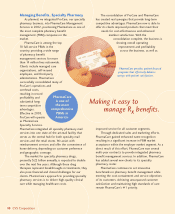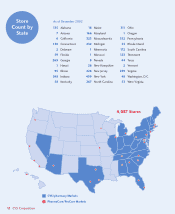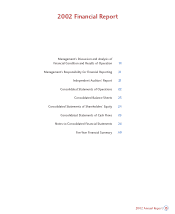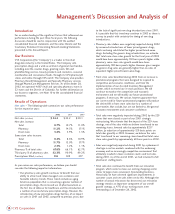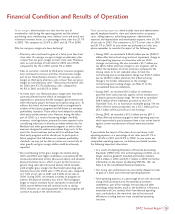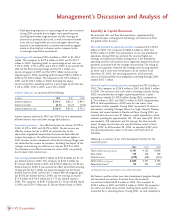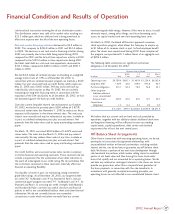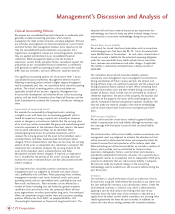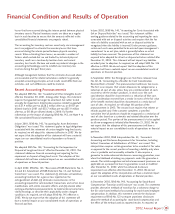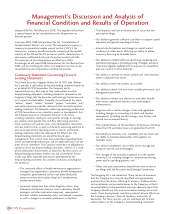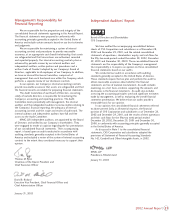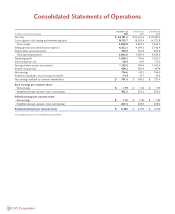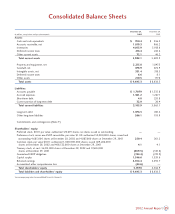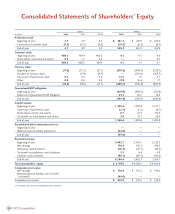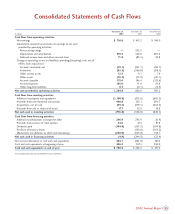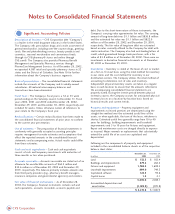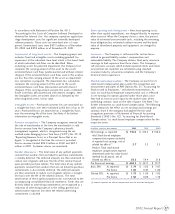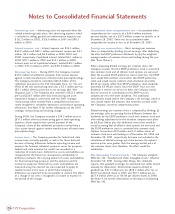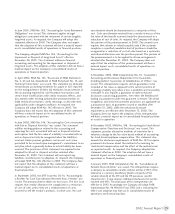CVS 2002 Annual Report Download - page 21
Download and view the complete annual report
Please find page 21 of the 2002 CVS annual report below. You can navigate through the pages in the report by either clicking on the pages listed below, or by using the keyword search tool below to find specific information within the annual report.
losses that have occurred during the interim period between physical
inventory counts. Physical inventory counts are taken on a regular
basis in each location to ensure that the amounts reflected in the
consolidated financial statements are properly stated.
The accounting for inventory contains uncertainty since management
must use judgment to estimate the inventory losses that have
occurred during the interim period between physical inventory
counts. When estimating these losses, we consider a number of
factors, which include but are not limited to, historical physical
inventory results on a location-by-location basis and current
inventory loss trends. We have not made any material changes in the
accounting methodology used to establish our inventory loss
reserves during the past three years.
Although management believes that the estimates discussed above
are reasonable and the related calculations conform to generally
accepted accounting principles, actual results could differ from our
estimates, and such differences could be material.
Recent Accounting Pronouncements
We adopted SFAS No. 142, "Goodwill and Other Intangible Assets"
effective December 30, 2001. Among other things, this statement
requires that goodwill no longer be amortized, but rather tested
annually for impairment. Amortization expense related to goodwill
was $31.4 million pre-tax ($28.2 million after tax, or $0.07 per
diluted share) in 2001 and $33.7 million pre-tax ($31.9 million
after-tax, or $0.08 per diluted share) in 2000. For further
information on the impact of adopting SFAS No. 142, see Note 4 to
the consolidated financial statements.
In June 2001, SFAS No. 143, "Accounting for Asset Retirement
Obligations" was issued. This statement applies to legal obligations
associated with the retirement of certain tangible long-lived assets.
As required, we will adopt this statement effective in 2003. We do
not expect that the adoption of this statement will have a material
impact on our consolidated results of operations or financial
position.
We adopted SFAS No. 144, "Accounting for the Impairment or
Disposal of Long-Lived Assets" effective December 30, 2001. This
statement addresses financial accounting and reporting for the
impairment or disposal of long-lived assets. The adoption of this
statement did not have a material impact on our consolidated results
of operations or financial position.
In April 2002, SFAS No. 145, "Rescission of FASB Statements No. 4,
44 and 64, Amendment of FASB Statement No. 13, and Technical
Corrections" was issued. This statement (i) eliminates extraordinary
accounting treatment for a gain or loss reported on the
extinguishment of debt, (ii) eliminates inconsistencies in the
accounting required for sale-leaseback transactions and certain lease
modifications with similar economic effects, and (iii) amends other
existing authoritative pronouncements to make technical corrections,
clarify meanings, or describe their applicability under changed
conditions. As required, we will adopt SFAS No. 145 effective in
2003. We do not expect that the adoption of this statement will
have a material impact on our consolidated results of operations or
financial position.
In June 2002, SFAS No. 146, "Accounting for Costs Associated with
Exit or Disposal Activities" was issued. This statement nullifies
existing guidance related to the accounting and reporting for costs
associated with exit or disposal activities and requires that the fair
value of a liability associated with an exit or disposal activity be
recognized when the liability is incurred. Under previous guidance,
certain exit costs were permitted to be accrued upon management's
commitment to an exit plan, which is generally before an actual
liability has been incurred. The provisions of this statement are
required to be adopted for all exit or disposal activities initiated after
December 31, 2002. This statement will not impact any liabilities
recorded prior to adoption. As required, we will adopt SFAS No. 146
effective in 2003. We do not expect that the adoption of this
statement will have a material impact on our consolidated results of
operations or financial position.
In September 2002, the Emerging Issues Task Force released Issue
No. 02-16, “Accounting by a Reseller for Cash Consideration
Received from a Vendor”. The pronouncement addresses two issues.
The first issue requires that vendor allowances be categorized as a
reduction of cost of sales unless they are a reimbursement of costs
incurred to sell the vendor’s products, in which case, the cash
consideration should be characterized as a reduction of that cost.
Cash consideration received from a vendor in excess of the fair value
of the benefit received should be characterized as a reduction of
cost of sales. As required, we will adopt this portion of the
pronouncement in 2003. The second issue requires that rebates or
refunds payable only if the customer completes a specified
cumulative level of purchases should be recognized as a reduction of
cost of sales based on a systematic and rational allocation over the
purchase period. This portion of the pronouncement is to be applied
to all new arrangements initiated after November 21, 2002. We do
not expect that the adoption of this pronouncement will have a
material impact on our consolidated results of operations or financial
position.
In November 2002, FASB Interpretation No. 45, “Guarantor’s
Accounting and Disclosure Requirements for Guarantees, Including
Indirect Guarantees of Indebtedness of Others” was issued. This
interpretation requires certain guarantees to be recorded at fair value
as opposed to the current practice of recording a liability only when
a loss is probable and reasonably estimable. It also requires a
guarantor to make enhanced disclosures concerning guarantees, even
when the likelihood of making any payments under the guarantee is
remote. The initial recognition and initial measurement provisions are
applicable on a prospective basis to guarantees issued or modified
after December 31, 2002, while the enhanced disclosure
requirements are effective after December 15, 2002. We do not
expect the adoption of this interpretation will have a material impact
on our consolidated results of operations or financial position.
In December 2002, SFAS No. 148, “Accounting for Stock-Based
Compensation–Transition and Disclosure” was issued. This statement
provides alternative methods of transition for a voluntary change to
the fair value based method of accounting for stock-based employee
compensation. In addition, this statement amends the disclosure
requirements of SFAS No. 123 to require prominent disclosures
about the method of accounting for stock-based compensation and
the effect of the method used on reported results. As required, we
Financial Condition and Results of Operation
19
2002 Annual Report



